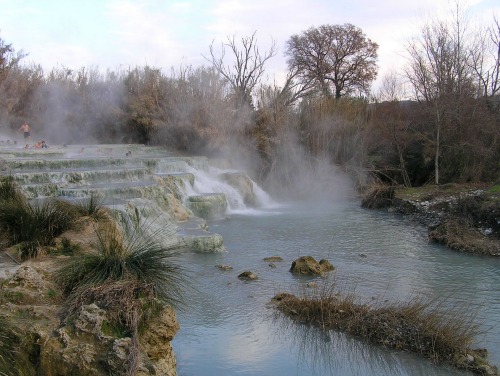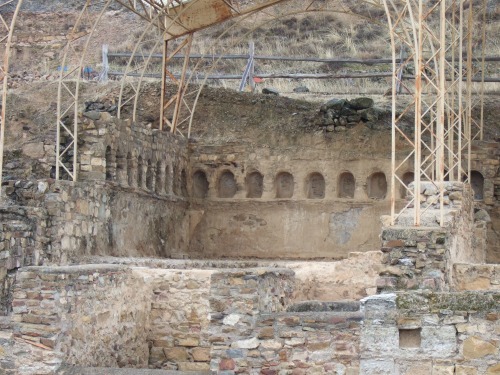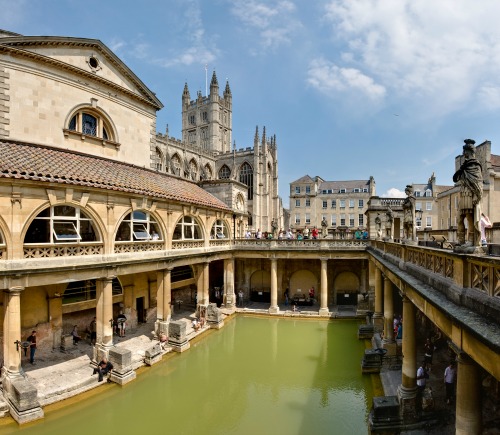For as far back as the Bronze Age man has been revitalizing himself with spa treatments in one way, shape, form or another. As Valentine’s Day approaches I am anxiously awaiting a day spa gift card, although I will probably have to settle for a box of chocolates. I did however, get to wondering just when such a revitalizing concept as visiting a spa was born.
Circa 3000 B.C
Archeological findings have unearthed pre-historic artifacts near various hot and cold water springs in Europe dating back to 3000 B.C., or so. Back then, man had to seek out and find hot or cold spring waters, but he was intelligent enough to know that soaking in fresh water to renew oneself was quite an experience.
Originally these treatments were alleged to be used for physical and spiritual purification. Perhaps combined with a ritual or ceremony, and the event took place right on sight, mother-nature style, near the water source.
Circa 2000 B.C to 400 A.D.
Sometime around mid 2000 B.C. the Grecians took the spa concept further by building bathing houses of stone. Often these bathing facilities were carved into the stone on a mountain side where hot spring waters were found.
Grecian bath houses were built in conjunction with athletic-type arenas and bathing became a communal activity used for self cleansing, healing and purification.

The Romans took the spa experience further, building larger and more ornate bath houses often utilizing their aqueduct system.
In far reaches of the Roman Empire, spas such as those found in Bath England were constructed during the Empire’s reign all for the intention of rest, relaxation, healing and socializing.
The concept of healing through mineral and thermal bath spa treatments had been almost constant throughout the history of spas up through the 6th century.
Circa 500 A.D. to 1500 A.D.
Bathing and spa usage ebbed and swayed during medieval times, succeeding the fall of the Roman Empire. Many of these extravagant bath houses were abandoned and some eventually destroyed. Vagrant types took refuge in these buildings and illicit behavior became frequent within these settings. Disease spread, thus causing the general population to hold the belief that bathing too often could cause illness, rather than deter it.
Circa: 1600 A.D.
By the seventeenth century, the upper class popularly believed that bathing was low class. Cleaning oneself was done on a minimal and infrequent basis.
Circa: 1700 A.D.
As the eighteenth century approached, the upper class fell in love, once again with the concept of bathing and since that time spas around the world have been associated and frequented by the upper class and used for healing, relaxation, pampering and wellness.
Circa: 1800 A.D.
By the nineteenth century public and private bath houses were constructed, refurbished or rebuilt and it was a normal practice to visit one primarily for the purpose of cleansing and refreshing, yet all the lavishness of the earlier days was replaced with practicality and purpose.
Circa: 1900 A.D. to today
As methods for indoor plumbing became available, public bath houses and spas began to take a back seat to at-home bathing rituals.

Although the bath house and spa ideals of old are mostly gone with history, there are some from the past still in existence around the world. Buckstaff Baths in Hot Springs, Arkansas, has been in service since 1912 and offers therapeutic mineral water treatments for healing and relaxation.

Nowadays, people attempt to create the magnificence of the bath spa, whether on a large or small scale in hotels, motels and their own homes.
I hope you enjoyed the travel back in time to what I dare to call “the roots of bathroom design”.
If you would like to see a bunch of bath house and spa inspired photos, follow or check out my Bath House and Spa board on Pinterest.
Thank you for stopping by, and I hope you are having a SPActacular day ~ Amy




Mel says
Oh the romans were the best! My kids are really into history and I have to say I think I would’ve liked to have been Roman if I was born that far back in history. We have natural mineral spas about 40 minutes away when I was a kid it wasn’t really popular and we used to go and swim it was fun to be in the bubbling water, now the town is a massive tourist town and crikey it’s expensive up there.
Doreen@househoneys says
Very interesting Amy! Yes, I have to agree that the Romans knew how to indulge…a practice that ultimately led to their demise I’m afraid. We visited the ruins of some Roman baths a few years ago. They certainly didn’t do anything on a small scale.
Danni@SiloHillFarm says
That was very interesting and informative! I am too much of a germophobe to relax and enjoy a spa, or a hot tub or even a spa tub! *sigh*
heather f says
So, this is a very timely post because my former sis-in-law just shared something about how taking nightly baths is SCIENTIFICALLY proven to be healthful, especially if you incorporate essential oils and bath salts. It’s an old fashioned activity that forces you to relax and be in the moment. It takes your mind of your cares and helps reduce your stress levels. uhhhh…yeah. I could have told them that without a scientific study. 🙂 I take a bath almost every night and relax and read, and I just love it.
Feral Turtle says
What a wonderful post! I love a hot bath at night! I will keep my fingers crossed for you and maybe you will get a wonderful spa gift! (hint hint to your hubby)!!!!!!